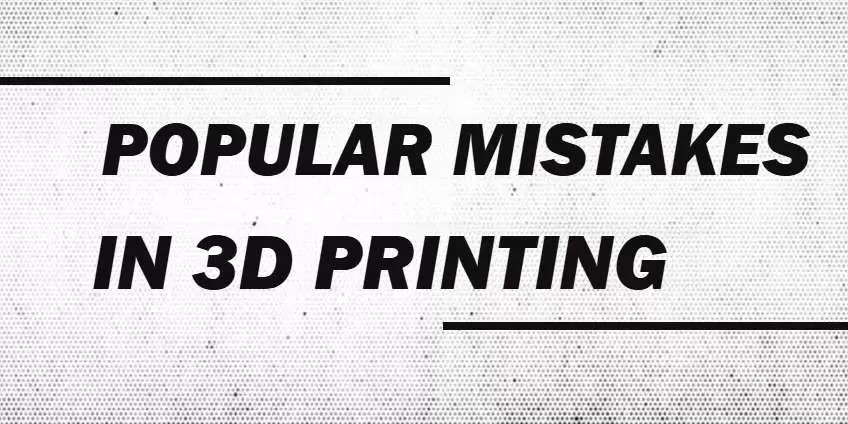5 Popular Mistakes in 3D Printing
If you think you have understood the 3D printing technology well, think again. While you evaluate your knowledge, you might come to know of the hoards of software, different materials to print, distinct kinds of 3D printers and all the more varied 3D printing technologies.
And with so many variations, if you find yourself satisfied by understanding only a large format 3D printer, or by getting information of only a dual extruder 3D printer, you have simply achieved nothing.
3D printing is way, way more than this. And before anything else, it is required to draft a perfect 3D model, so that you could achieve similar spectacular outcomes.
However, while you design 3D models, you always need to keep track of a few considerations which help to achieve better results. But against this, people generally do not mind the basic details and commit some serious mistakes which are as follows:
Disregarding The Material Guidelines:
Just as the character ‘A’ differs from ‘B’, each and every printing material differs a great deal from its similar relative. Some of these are brittle, while the others tend to be strong. Some are smooth, whereas others might be rough. Also, some could be heavy, while there could be lighter ones too.
As of this, the model you design should always be according to the specific materials you use. For instance, if you print ceramic 3D models, there are certain specific guidelines related to inclinations and overhangs that you always need to adhere to.
Non-adherence to any such details could always be a hurdle to your path to perfectness, and a grave mistake that should be avoided.
Neglecting The Print Technology:
Besides the print materials that differ a great deal, the printing technologies too could be of various types. And ignoring the technological aspects of 3D printing could always prove a costly affair for you.
For instance, the materials such as Alumide, ABS, Rubber or Polyamide etc. could be used to print interlocking parts, but this is certainly not possible with metals such as Gold and silver, or Resin etc. Why? Not because of the material, but due to the technology that is employed to print the same.
For ABS, the best technology available is ‘Fused Deposition Modeling’, while the precious metals are printed using lost wax casting method. And while you do not adhere to this, this could be a blunder to ruin your final 3D printed model.The Base Material: This is used to construct the exteriors of the products
Overlooking The Thickness Of Wall:
The Conductive Material: This is used to formulate circuitry (which is generally the inside portion)
Do you know the most common reasons why some of the perfect 3D models are not fit to be printed? It is because people commit mistakes by overlooking the wall thickness of the printable objects.
If the walls are too thin, the printed products might be too fragile to allow quick rupture of the product on slightest of pressure. Against this, if you print the walls too thick, the print materials might suffer wastage. Also, thicker walls generate much of internal stresses, which cause the product to break or crack.
Therefore, while you draft a 3D printable model, do not forget to check the wall thickness and ensure it to be optimum.
Disregarding the File Resolution:
Electronics are built secluded from the part fabrication procedure
You did everything alright: perfect printing materials, immaculate technology, and even the wall thickness is perfect. But wait. Did you ignore the file resolution? If yes, you committed a big, big mistake.Electronics are built within the part production process
In 3D Printing, we mostly employ the STL (Standard Triangle Language) file format. This means that the designs we feed would be translated to triangles within a 3D space. Many of the 3D modeling software facilitate the export of a 3D design to an STL file and then position the desired resolution.
And the file resolution should be utmost appropriate since neither the high-ones nor the low-resolution files offer appropriate results.
Not Adhering To The Software Guidelines:
No matter it’s the best 3D printer you use to print the objects, if you overlook the software guidelines, you are going nowhere.
There are hoards of 3D modeling software packages. Some of these are designed to offer automatic results, while in some, you would manually need to set the specifications. Graphene: Graphene is a type of graphite that has high thermal and electric conductivity. Plus, it is flexible, transparent and is highly suitable for manufacturing the integrated circuitry in electronics.
For instance, some software might facilitate automatic application of wall thickness, while in others, you need to set it manually, before you offer it to your desktop 3D printer for printing. Nanomaterials: These are the materials which contain particles of some conductive materials such as conductive copper or silver in nanoscale measurement. The inks are said to be highly conductive in nature and promise various applications.
And in all this, you would always require to keep track of the software guidelines, ignoring which could affect your 3D prints a great deal.
These are some of the most common mistakes relating 3D models that are usually committed by hoards of people. No doubt you employ the best 3D printer, if you ignore even one of the modeling aspects, this is bound to create hurdles and affect your final 3D printed outcomes.
If you need cnc machining Guide or services check cncfirst for extensive information. It covers all the area and gives you vast information about cnc machining knowledge.
Image credits : InkPal

